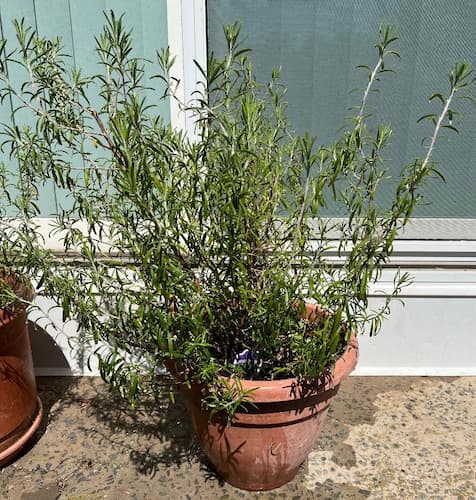How to Grow Rosemary Herb Plants

About Growing Rosemary Plants in Your Herb Garden
Looking for another rewarding plant to add to your herb garden!? Try growing Rosemary paltns. With thin, dark green leaves and pale blue flowers, Rosemary herbs are a popular and attractive herb. It is an evergreen shrub. Rosemary plants are members of the mint family. They grow wild in the Mediterranean region. It is a perennial in warm areas. It is susceptible to frost and therefore, is grown as an annual in many parts of the country.
Young plants can be grown like houseplants until they get big. Then, move them outside to their permanent summer home. They will look and grow well in your garden, or along the house. Also, try growing Rosemary in big containers on your deck.
Did You Know? Rosemary plants are good companions with plants from the cabbage family. It protects them from pests. More on Companion Plants
Flowers Bloom: Spring to Summer
Flower Colors: Blue
Plant height: 3 to 6 feet tall.
Hardiness Zones: 7 – 10.
Perennial, Rosemarinus Officinalis
Medicinal and Culinary Uses
Medicinal Uses:
Rosemary herb has been used to treat both stomach aches and headaches. It can help to ease gastro-esophageal reflux disease.
It is also believed to aid in memory retention. I’m personally going to give this a try. Now, if I can only remember where I stored my Rosemary……
The oil of Rosemary is used in perfumes and cosmetics. It has also been used as a moth repellent.
Culinary Uses:
The leaves are used fresh, dried, or frozen in many recipes. It commonly is used on meats (beef, chicken, ribs), stews, sauces, and soups.
Brew some fresh Rosemary in tea, adding a few fresh or dried leaves.
Rosemary Plant Propagation
Rosemary bushes are started from seed. The seed is hard to start. Soak Rosemary seeds in water a few hours before planting. We recommend starting them indoors, as they take a long time to sprout. Start seed indoors six weeks before the last frost.
Note: For indoor starts, we recommend using a heated germination mat, to increase the speed of germination. And, it, results in a higher germination rate.
If you want to grow and enjoy them as houseplants, start them indoors even earlier. After they sprout, place them in a warm, sunny window.
When transplanting outdoors, space plants three feet or more apart. In warm areas where there is no frost or freezes, pick a place where the plant can grow for many years.
Final Plant Spacing: 2 to 3 feet apart.
Days to Germination: 15 – 25 days.
How to Grow Rosemary Plants
Growing Rosemary plants is very easy. They prefer full sun to partial shade. They will do well in almost any soil. The plants tolerate dry soil conditions and drought. They should not require water during droughts, but add water if they appear to wilt. They usually do not require fertilizer, except for container-grown plants.
Once your Rosemary shrub reaches a couple of feet, don’t hesitate to bring out the shears and shape them. Be creative if you dare!
Harvest leaves and use fresh, as needed, in the summer. As autumn arrives, harvest leaves in the morning, when the oils are at their peak. Spread leaves out to dry in a cool, well-ventilated area. Or, pick and freeze immediately.
If you are growing Rosemary in containers, you can over-winter plants in a greenhouse in some areas.
Ideal pH: 6.5 – 7.5
Insect and Plant Disease Problems
Related Articles
Also, people who liked this article will also like:
How to Grow Marjoram by Garden Hobbies
Please support our site. Shop for:
- rmmatthews100@hotmail.com
- 585-721-6528
- Rochester, NY
©1999-2024 GardenersNet.Com, All Rights Reserved

